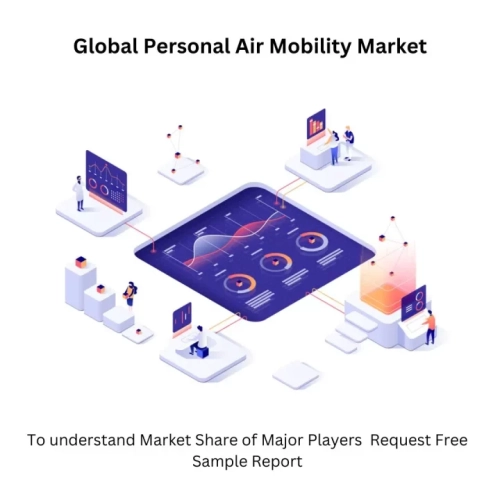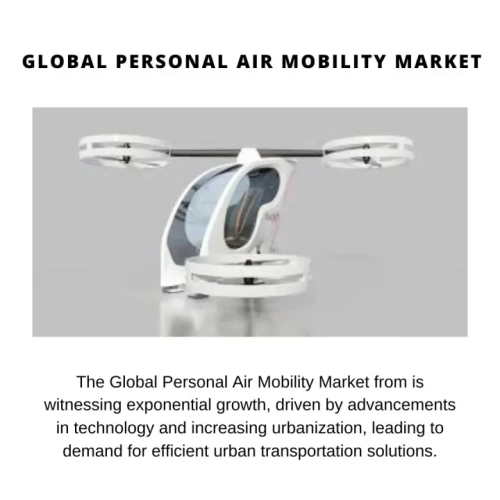
- Get in Touch with Us

Last Updated: Apr 25, 2025 | Study Period: 2024-2030
The Global Personal Air Mobility Market is poised for significant growth in the coming years, driven by a confluence of factors. Increasing urban traffic congestion and the growing demand for faster commutes are creating a need for alternative transportation solutions. Technological advancements in electric vertical takeoff and landing (eVTOL) aircraft are making personal air mobility a more realistic possibility.
This market encompasses a variety of vehicles, including electric flying taxis, personal eVTOLs, and even autonomous drones for personal use. While regulations and safety concerns remain hurdles, government initiatives and investments in smart city development are fostering a supportive environment for personal air mobility. The market is expected to witness a surge in passenger transportation, offering time-saving options for short and medium-range travel within and between cities. Advancements in battery technology and electric motors are addressing range limitations, making eVTOLs more practical for personal use.
The intracity segment is likely to dominate the market initially, with personal eVTOLs designed for urban commutes. However, the intercity segment is expected to grow rapidly as eVTOL range improves. This could revolutionize travel, making far-flung destinations more accessible.
On the flip side, public acceptance of personal air vehicles in populated areas is a question mark. Noise pollution and safety concerns need to be addressed to gain public trust. Additionally, infrastructure development for vertiports, designated landing and takeoff zones for eVTOLs, will be crucial for large-scale adoption.
Despite the challenges, the potential benefits of personal air mobility are undeniable. It offers the prospect of decongesting roads, reducing travel times, and creating a new mode of transportation that is both efficient and environmentally friendly. Major players in the aerospace and automotive industries are actively involved in developing eVTOL vehicles. This intense competition isaccelerating innovation and driving down costs, making personal air mobility a more viable option for consumers.
As the market matures, we can expect to see a wider variety of personal air vehicles catering to different needs and budgets. This could lead to a paradigm shift in urban transportation, transforming how we travel and experience our cities.The long-term success of the global personal air mobility market hinges on overcoming regulatory hurdles, ensuring safety, and addressing public concerns. However, with continued technological advancements and increasing investments, this market holds immense potential to revolutionize personal transportation in the years to come.
Personal Air Mobility (PAM) refers to the use of small aircraft, typically with vertical takeoff and landing capabilities, to provide on-demand transportation services for individuals or small groups. These aircraft, often referred to as electric vertical takeoff and landing (eVTOL) vehicles, offer a new mode of transportation that aims to alleviate urban congestion, reduce travel times, and provide more efficient and flexible mobility options.
There are several types of personal air mobility vehicles, including electric vertical takeoff and landing (eVTOL) aircraft, electric helicopters, and autonomous drones. These vehicles can vary in size, capacity, and range, catering to different use cases ranging from urban commuting to recreational flying. Benefits of personal air mobility include reduced travel times, decreased congestion on roadways, lower emissions compared to traditional vehicles, and increased accessibility to remote or hard-to-reach areas.
However, along with the promising benefits, personal air mobility also presents certain risks and challenges. Safety concerns related to airspace congestion, collision avoidance, and vehicle reliability are paramount and require rigorous regulatory oversight and technological advancements to mitigate.
Additionally, infrastructure challenges such as the need for vertiports, charging stations, and integration with existing transportation networks pose significant hurdles to widespread adoption. Public acceptance and perception of personal air mobility also play a crucial role, requiring education, demonstration projects, and community engagement to address concerns and build trust in these emerging transportation solutions.

The Global Personal Air Mobility Market accounted for $XX Billion in 2023 and is anticipated to reach $XX Billion by 2030, registering a CAGR of XX% from 2024 to 2030.
Joby Aviationintroduced theJoby eVTOL, which boasts impressive specifications, including a range of up to 150 miles on a single charge and a top speed of 200 mph. Equipped with six electric motors for vertical takeoff and landing capabilities, the Joby eVTOL offers a smooth and quiet flight experience, minimizing noise pollution in urban environments. With a spacious cabin accommodating up to four passengers, including the pilot, the Joby eVTOL prioritizes comfort and convenience for its users.

Liliumintroduced theLilium Jet, a revolutionary electric vertical takeoff and landing (eVTOL) aircraft. The Lilium Jet boasts remarkable specifications, including a range of up to 186 miles and a cruising speed of 175 mph, making it well-suited for urban air transportation. With its distinctive design featuring 36 electric ducted fans distributed across its wings, the Lilium Jet offers a smooth and efficient flight experience while minimizing noise emissions. Its spacious cabin can accommodate up to six passengers, providing a comfortable and luxurious travel environment.
Vertical Aerospaceintroduced theVA-X4, an advanced electric vertical takeoff and landing (eVTOL) aircraft designed to transform urban transportation. The VA-X4 features impressive specifications, including a range of up to 100 miles and a top speed of 150 mph, making it ideal for short to medium-haul flights within urban areas. With its innovative design comprising four tilting rotors and a sleek aerodynamic profile, the VA-X4 offers a smooth and quiet flight experience while minimizing its environmental footprint. The spacious cabin of the VA-X4 can accommodate up to four passengers, providing comfort and convenience for urban commuters.
| Sr. no | Topic |
| 1 | Market Segmentation |
| 2 | Scope of the Report |
| 3 | Research Methodology |
| 4 | Executive Summary |
| 5 | Introduction |
| 6 | Average B-2-B Selling Price in Past 5 Years |
| 7 | Insights from Industry Stakeholders |
| 8 | Cost Breakdown of Product Components and Average Profit Margin |
| 9 | Disruptive Innovation in the Industry |
| 10 | Technological Innovations in Global Personal Air Mobility Market 2024-2030 |
| 11 | Electric Propulsion Systems Advancements |
| 12 | Autonomous Flight Technology Integration |
| 13 | Battery and Energy Storage Innovations |
| 14 | Aerodynamic Design and Efficiency Enhancements |
| 15 | Connectivity and Communication Solutions |
| 16 | Air Traffic Management and Control Systems |
| 17 | Infrastructure Development for Urban Air Mobility |
| 18 | Aircraft Health Monitoring and Maintenance Systems |
| 19 | Human-Machine Interface Design Improvements |
| 20 | Integration of Artificial Intelligence in Flight Operations |
| 21 | New Product Development in the Past 12 Months |
| 22 | Market Size, Dynamics, and Forecast by Geography (2024-2030) |
| 23 | Market Size, Dynamics, and Forecast by Vehicle Type (2024-2030) |
| 24 | Market Size, Dynamics, and Forecast by Application (2024-2030) |
| 25 | Market Size, Dynamics, and Forecast by Propulsion System (2024-2030) |
| 26 | Competitive Landscape and Market Share Analysis |
| 27 | Growth Strategy of Leading Players |
| 28 | Market Share of Vendors (2023) |
| 29 | Company Profiles |
| 30 | Unmet Needs and Opportunities for New Suppliers |
| 31 | Conclusion |